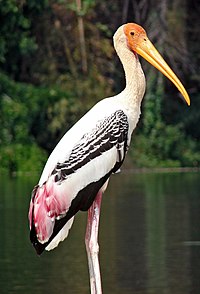Ranganathittu Bird Sanctuary – Karnataka 24/06/2019 – Posted in: Daily News
RANGANATHITTU BIRD SANCTUARY
It is also known as Pakshi Kashi of Karnataka.
- It is the largest bird sanctuary in the state and comprises six islets on the banks of the Kaveri river.
- Over 200 species of migratory and Indian birds, at least 60,000 in number, arrive here every year for nesting and breeding. The sanctuary is an important bird sanctuary of India.
- It was formed when Kanteerava Narasimharaja Wadiyar of the then Mysuru royal family constructed an embankment across the Cauvery in 1648. Ranganathittu became a “bird sanctuary” in 1940 owing to the initiatives/interest of noted ornithologist Salim Ali.
- During winter months, starting from mid-December, as many as 40,000 birds congregate in this bird sanctuary. Of these, some birds come from Siberia, Latin America and parts of north India.
Flora: Riverine reed beds cover the banks of the islands, while the islands themselves are covered in broadleaf forests, with dominant species being Terminalia arjuna (Arjun tree), bamboo groves, and Pandanus trees. Eucalyptus and acacia trees have also been planted, which might lead to long-term eradication of native species. The endemic and threatened lily Iphigenia mysorensis of the family Colchicaceae also grows in the sanctuary.
Fauna: The islands are host to numerous small mammals, including bonnet macaque, smooth coated otter, colonies of flying fox and common small mammals like common palm civet and Indian gray mongoose and the monitor lizard. The mugger crocodile or marsh crocodile is a common inhabitant of the riverine reed beds and Ranganathittu has largest fresh water crocodile population in Karnataka state.
Birds: Roughly 170 bird species have been recorded here. Of these, the painted stork, Asian openbill stork, common spoonbill, woolly-necked stork, black-headed ibis, lesser whistling duck, Indian shag, stork-billed kingfisher, egret, cormorant, Oriental darter, spot-billed pelican and heron breed here regularly. The great stone plover, and river tern also nest here. The park is home to a large flock of streak-throated swallows.
Source: The Hindu
You can follow us on LinkedIn and for more updates related to UPSC IAS Preparation, Like our Facebook Page and subscribe our Diligent IAS Youtube Channel
Also, Read Related Daily News
- Man-Portable Anti-Tank Guided Missile
- Directorate of Revenue Intelligence
- US report on Religious Freedom
- Southwest Monsoon
- National Employment Board
- All about Cess
- 34th ASEAN Summit

